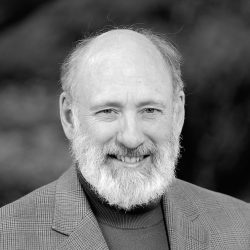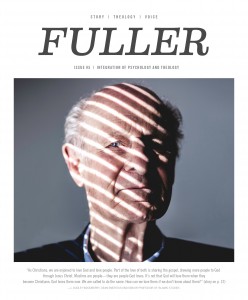
+ The nexus where theology and psychology integrate is more than a philosophical juncture, it is a place where people meet. The bricks and mortar of Fuller’s C. Davis and Annette Weyerhaeuser School of Psychology complex serve the people engaged in those meetings. There, people gather for therapy, classes, lectures, informal dialogue, research, study sessions, prayer, and conversation. A host of resources makes this possible, including grants totaling nearly $5 million managed by Fuller’s Thrive Center. These grants enable research on topics as diverse as virtue development, spiritual formation, psychology of religion in Chinese society, and academic and social emotional functioning in ethnic minority youth. This robust activity is evidence of the widespread application of a commitment to integration between theology and psychology at Fuller.
Our young Chinese guide was explaining various points of historical and cultural interest around China’s scenic Huangshan Mountain—all the while taking “selfies.” She admired all things Western. She had taught herself English by watching American movies, and any new word I (AD) uttered, she asked for a definition and put it in her personal “dictionary.” Given her more collectivist society, her behavior seemed most incongruous. What appears to be happening is that, globally, interdependent cultures and selves are simultaneously becoming more independent.1 How does the fact of shifting culture influence the dialogue between our faith and practice as psychologists?
Too often we assume that within the person there is a central core processor that is universal. Culture adds only a few local flourishes.2 Over the past 40 years, psychological research that takes the social and cultural context more seriously has provided us with a treasure trove of findings that support the notion that differences in cultures and communities are reflected in the individual.3
But how do cultures and communities vary? Some communities/cultures are thick, saturated with a network of relationships that provide mutual support, while other communities are thin, providing few significant relationships with most of those relationships judged by their usefulness.4 However, it is possible for a given individual to have both a small social circle of family and trusted friends and at the same time have a broad range of acquaintances and social circles. They differ in the time spent together, emotional intensity, level of intimacy and transparency, and support and reciprocity.5 One’s work group is different in relational quality from a circle of stamp collectors. Persons with thick relational communities may have different faith experiences, motivation, identity, emotions, and relationships than a person in thin relational communities.
Societies also differ in the number of communities that prioritize the flourishing of the individual or valorize the common good. In the first, where the person is the center of attention, it is hoped that this individual will grow to be autonomous, authentic, respectful of others, and from this position of independence, to develop significant relationships with others. At best, this individual possesses self-confidence and is unique, assertive, expressive, and intentional.6
In other communities, and even within the same individual, there is an emphasis on the whole of which the individual is a part. Here social harmony is highly valued. The healthy individual is one who is aware of the needs of the other and willing to accommodate. The larger whole is acknowledged more often than the individual part. The model individual is one capable of controlling his or her own emotions, sacrificing on behalf of the other, belonging, fitting in, maintaining harmony, and promoting others’ goals.7
So it appears that our thoughts, feelings, actions, and relationships are constituted in a dynamic relationship with one’s cultural environment. Our meanings, attitudes, images, representations, and cultural products are shaped by interpersonal interaction, institutional practices, and systems. In the United States, Markus and Conner found more independent self-construal among males, the upper- class, non-religious individuals, and Caucasians, but greater interdependence among females, the lower-class, religious individuals, and ethnic minorities.8 People develop both styles of self-construal, but the societal triggers that evoke these syndromes vary such that one pattern is privileged over another in different communities, societies, and cultures. If cultures and communities are powerful factors in shaping personal experience, one would expect that the psychological nature of religious experience would reflect the cultural context. So when it comes to the task of integrating psychology and theology, culture matters. We begin with how the experience of the Korean ethnic church with its cultural history of trauma has shaped the individual as he or she immigrated to the United States. It appears that capitalism and a particular style of being the church have engendered a corrosive individualism. We then reflect on spiritual conversion in more rich, relational communities using the example of Chinese churches. In each case more than the individual’s motivation is needed to explain behavior. Thick integration calls for complex dialogue, while thin integration ignores culture as a partner in the conversation between theology and psychology.
INDIVIDUALISM IN THE ETHNIC KOREAN AMERICAN CHURCH
Korea as a nation has had to cope with chronic invasions by different foreign powers and multiple strains of oppression throughout history. For 4,000 years of existence Korea has not had a moment of peace, leaving marks on the Korean collective psyche and character.9 Han is a term that has been used in daily life among Korean people since ancient times to describe the depths of human suffering or “frustrated hope,” and it is still commonly referred to by those who lived through the Korean War. The collective han stemming from patriarchy, hierarchy, and foreign intervention is indigenous to Korean people and deeply saturates every segment of the Korean culture and way of life.10 One cannot understand the individual Korean psyche apart from this historical context.
Most immigrant parents are reticent to share details of their losses and the dislocation they experienced as children during the Korean War. Often only fragments of fleeing the war zone and battling extreme poverty and hunger are retold to the next generation. Though they may not have been directly exposed to the event, powerful collective experiences of trauma can be transmitted across generations, often in complex and implicit ways, and the urgency for family security may be internalized and identified by the children of survivors.11 In addition, group trauma can be subsequently perpetuated through microaggressions, another form of abuse involving daily discrimination and racism for immigrants and ethnic minorities living in the United States.12 Reflecting on the destruction, loss, and poverty that profoundly shaped a nation facilitates a deeper understanding of Korean immigrants’ responses to the historical trauma. Linking the historical to the personal allows one to be compassionate and empathic through understanding.
The Korean immigration to the United States was prompted in large part by the 1965 reform of US immigration law and a desire to escape the political, economic, and social upheavals of war. As a result of the new wave of immigrants, Korean churches grew from only 30 in the late 1960s to 4,233 by 2013.13 Such explosive growth brought the unintended problem of increasing individualism in Korean ethnic churches. What is unique to Korean immigrants in recent times is that a history of trauma has fatally merged with the individualistic materialism that drives America. Not only did financial success satiate internal needs, but Korean immigrants also found that capital was equated with acceptance in a country that rejected them as aliens. Individually acquired wealth became a natural crutch to lean on, as it provided tangible means to measure immigrant success. This unhealthy focus on obtaining economic security has, unfortunately, reinstated the traditional Korean class structure that separated the haves and have-nots. This division within the church inevitably created a fragmented community, vulnerable to interpersonal conflict. While needing to reconcile structural isolation and social marginalization in this country as a minority, the congregation also needed to transform the class-based anxiety accentuated by a history of trauma and immigrant experience within the group.
In the 1970s when the Korean community was in early stages of development, Korean churches provided assistance to facilitate immigrant families’ adaptation to America by offering information about housing and employment, language assistance, and enrolling children in school. By catering to these pressing needs, the church inadvertently nurtured a self-serving dependency. Many Korean immigrants came to the church with the misguided notion of one-sided receiving and only remained at a church if the individual needs were being fulfilled. If such members were not happy, they left for the next religious community promising immediate satisfaction. Failure to address “church hopping” was a lost opportunity for Korean congregations to work through differences and embody Christ relationally by developing mutual trust, commitment, and maturity Rather than correcting the problem of self-interest, the sermons in Korean churches that focus exclusively on prosperity or how to receive God’s blessing often feed into unhealthy individualism. By emphasizing what people can “get” from God or the church, the true message of the gospel—Jesus’ sacrificial love—is downplayed or missed entirely. Prayers to God that focus exclusively on personal problems further contribute to individualistic pietism rather than strengthening the faith community.14 Problems commonly observed in Korean ethnic churches today are not issues that sprang up overnight, but reflect a history of unresolved trauma, loss, and suffering. Generational trauma and victimization manifests itself not only at the individual level but also in the collective psyche with societal consequence.
“Fuller has made this huge contribution as a school of psychology, yet our greatest contribution to the church . . . is to bring a healing presence to individuals, to children, and to couples in the name of our Lord in all the Christian communities that our graduates serve.”
+ WINSTON GOODEN is dean emeritus of Fuller’s School of Psychology and Evelyn and Frank Freed Professor Emeritus of Psychotherapy and Spirituality. This quote is taken from an Integration panel convened for the School of Psychology’s 50th anniversary.
CONVERSION IN MORE RELATIONAL COMMUNITIES/CULTURES
To understand the psychology and/or spirituality of an individual apart from his or her cultural context is like trying to understand the Apostle Paul as a generic human being rather than one deeply embedded in his Jewish culture. Krister Stendahl pointed out that Paul’s conversion was less like Luther’s and more like a vocation, a call to reconcile Jew and Gentile.15 Paul was an authentic and faithful Jew. He read the doctrine of justification by faith through the eyes of Habakkuk, not the failure of the Catholic Church. Like a good Jew, Paul believed we are saved by God’s faithfulness. So again culture matters. To assume that Paul’s ethos was the same as that of the Reformation or that people in different cultures are all the same tends to thin out the rich texture of human experience, whether Jew or Gentile.
In many Asian communities, coming to faith is not simply the individualistic decision so common in the Western world. In more collectivistic communities, we often see families converting to Christianity as a unit rather than simply as individuals. Chinese folk religions and Daoism incorporate ancestral worship and the concept of passing on the family torch. Thus, when a person converts to Christianity, they may be extinguishing this family torch. Hence, in deeply relational cultures one can be disowned for betraying the family by taking on new beliefs and practices as a Christian.
My (KW) wife was the first member of her family to become Christian after enduring a serious kidney disease. Initially, her conversion was not well accepted by her family. She was on a spiritual path different from her family members, and practically, she was no longer able to participate in traditional customs of ancestor worship. It was not until our wedding day that my wife’s family came into contact with Christianity. Upon finding that the wedding would be held at our church, my parents-in-law felt the need to check out this group. Through their interactions with our church, they became more socially comfortable there, which gradually melted the initial reluctance toward Christianity. Despite leaving Taiwan after our wedding, my parents-in-law continued on their own to stay connected socially with our former church. A part of it was related to a form of social reciprocity (renqing, 人情) since our church community had hosted our wedding. Several years later, my wife’s parents and her two sisters’ families became Christians.
The example of my wife’s family is in line with Katrin Fiedler’s essay that examines the communal nature of Protestant Christianity in China.16 She does so from a variety of angles: accessibility, group dynamics and perceptions, Christian gatherings as a leisure option, and the role of the family. Unlike Buddhist and Daoist worship that are more serious and individualized, Fiedler points out that Christianity offered a more socially interactive and engaging communal life for the Chinese populace. Members of the Chinese Christian church community not only conceptualize themselves as being a family in Christ, but literally address each other as brothers and sisters. The church also acts as a surrogate family system fulfilling a communal need when family ties are not strong due to conflict or migration.17 Consequently, there is often strong peer pressure to adhere to group norms and rules within the Chinese church community.18 The collectivistic Chinese values that emphasize relational favors and obligations play an important role in the church community as well. Individuals within the Chinese Christian community often view themselves with other Christian members as in-group and view non-Christians as out-group. And the implicit and explicit rules for members within the church community apply similarly to how rules and roles apply within a family. Therefore, there is often a more explicit and unified ethic and system of rules within many Chinese churches.
As mentioned earlier in this essay about the selfies taken by the tour guide, China is an evolving society strongly influenced by Western and individualistic values in secular and religious life. Not all Chinese are collectivists. Although China has a traditionally collectivistic culture, there are more individualistic influences in urban city settings. Many younger individuals in urban China explore Christianity because they view it as a trendy Western way of living. The urban churches may look a little bit more like those in Western settings compared to the ones in China’s rural areas. In sum, although we provide examples to illustrate the communal nature of Chinese Christians, the diversity in Chinese society should not be overlooked. This makes the task of thick integration of culture, faith, and practice a complex endeavor. Overgeneralizations about culture can lead researchers, therapists, and ministers working cross-culturally to make errors.
THICK CULTURAL INTEGRATION
If cultures are all the same, we can then export our theology and psychology without qualification. The integration of the two is then the same in all cultures. While cultures differ on many dimensions, we have focused on societies with thick relational networks versus thinner market-driven, individualistic communities. We have argued that these cultural and psychological differences impact the conversation between culture and faith differently for Korean Americans and for new Protestant Christians in China. While not all Korean churches are individualistic, cultural forces and church policy have colluded to increase individualism in many Korean immigrant churches. In China the embodied community of Christ is attractive precisely because it is more collective than individualistic.
Our hope is that the church would transcend the extremes of individualism and collectivism.19 Being the body of Christ requires emphasizing Jesus’ teachings calling for humility and courage. Only when the message of the cross is fully embraced can strong individuals in the church point to the kingdom of God in a world seeking justice and peace. Just as Christ calls us to be in union with him, the church can only be built through unity. Our brokenness at the individual, family, and social levels can be healed and brought to wholeness if we prioritize community building and consciously resist divisiveness. Whether individualistic or collectivistic, unless self-serving human tendencies are regenerated in Christ, churches cannot function as the loving community of God that seeks to be salt and light in a broken world.




